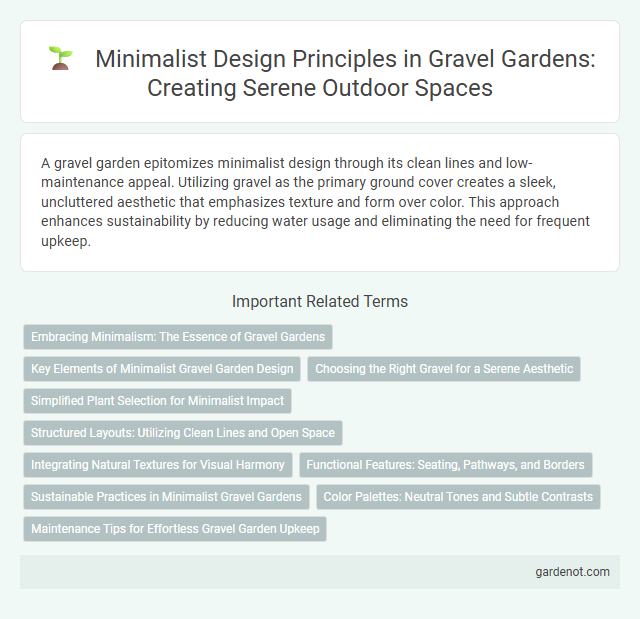A gravel garden epitomizes minimalist design through its clean lines and low-maintenance appeal. Utilizing gravel as the primary ground cover creates a sleek, uncluttered aesthetic that emphasizes texture and form over color. This approach enhances sustainability by reducing water usage and eliminating the need for frequent upkeep.
Embracing Minimalism: The Essence of Gravel Gardens
Gravel gardens embody minimalist design by emphasizing simplicity, clean lines, and natural textures, creating a tranquil outdoor space with minimal maintenance. The use of gravel as a primary ground cover reduces the need for extensive planting while enhancing drainage and preventing weed growth. This approach promotes a serene environment that highlights the beauty of stones and sparse, carefully selected plants.
Key Elements of Minimalist Gravel Garden Design
Minimalist gravel garden design emphasizes simplicity through the use of clean lines, limited plant variety, and natural materials like gravel and stone. Key elements include structured gravel beds, strategically placed succulents or ornamental grasses, and minimal decorative accents to maintain an uncluttered appearance. This approach enhances visual calmness, reduces maintenance, and creates a modern, serene outdoor space.
Choosing the Right Gravel for a Serene Aesthetic
Selecting the right gravel for a minimalist garden involves prioritizing texture, color, and stone size to create a clean and serene aesthetic. Opt for neutral tones like soft grays, whites, or beige that harmonize with natural surroundings and enhance simplicity. Fine or medium-sized gravel with uniform shapes supports a smooth, clutter-free appearance essential for minimalist garden design.
Simplified Plant Selection for Minimalist Impact
Minimalist gravel gardens emphasize simplified plant selection, prioritizing drought-tolerant and low-maintenance species like lavender, ornamental grasses, and succulents to create clean lines and uncluttered spaces. Carefully chosen plants provide visual interest and texture without overwhelming the gravel's neutral backdrop. Streamlined planting enhances the minimalist impact by maintaining balance and harmony in the garden's design.
Structured Layouts: Utilizing Clean Lines and Open Space
Gravel gardens emphasize minimalist design by incorporating structured layouts that highlight clean lines and open space, creating a sense of order and tranquility. The use of gravel as a ground cover enhances these elements, providing a consistent texture that contrasts with carefully selected plants and hardscape features. This approach maximizes simplicity and functionality, promoting low maintenance while achieving a visually striking garden environment.
Integrating Natural Textures for Visual Harmony
Minimalist garden design in gravel gardens emphasizes the integration of natural textures such as smooth pebbles, coarse gravel, and weathered wood to create visual harmony. This approach enhances the serene ambiance by balancing rough and smooth surfaces, fostering a tactile connection with nature. Selecting muted earth tones and organic shapes further strengthens the cohesive, tranquil aesthetic that defines minimalist gravel gardens.
Functional Features: Seating, Pathways, and Borders
Gravel gardens emphasize minimalist design by incorporating functional features such as clean-lined seating made from natural materials like wood or stone, which blend seamlessly into the landscape. Pathways crafted from compacted gravel provide efficient drainage and easy maintenance while guiding visitors through the garden's geometric layout. Borders defined by low-growing shrubs or metal edging create clear boundaries that enhance the garden's simple yet structured aesthetic.
Sustainable Practices in Minimalist Gravel Gardens
Sustainable practices in minimalist gravel gardens emphasize water conservation through drought-tolerant plant selections and efficient irrigation systems such as drip watering. Utilizing permeable gravel materials promotes natural groundwater recharge and reduces runoff, enhancing soil health. Incorporating native, low-maintenance plants minimizes the need for fertilizers and pesticides, ensuring an eco-friendly garden design.
Color Palettes: Neutral Tones and Subtle Contrasts
Gravel gardens with minimalist design emphasize neutral tones such as soft grays, beiges, and off-whites to create a calming, cohesive aesthetic. Subtle contrasts are achieved through the careful selection of plants with varying shades of green, muted blues, or pale lavenders, enhancing visual interest without overwhelming simplicity. This restrained color palette promotes tranquility while maintaining texture and depth within the minimalist gravel garden space.
Maintenance Tips for Effortless Gravel Garden Upkeep
Gravel gardens require minimal maintenance, with regular weeding and occasional raking to keep the surface clean and even. Applying a weed suppressant membrane underneath the gravel significantly reduces unwanted plant growth, ensuring effortless upkeep. Periodic topping up of gravel maintains its aesthetic appeal and prevents soil erosion.
Minimalist garden Infographic

 gardenot.com
gardenot.com